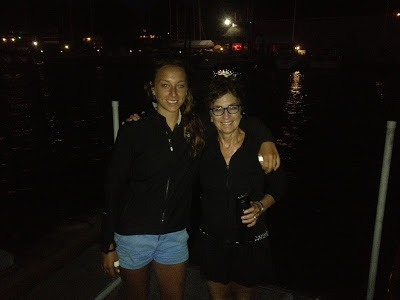It's all Lynne's fault.The lunacy, I mean. The Rim to Rim thing, the hills, the lemonade stand, the local 50 mile run, and how in love we all are with those Ethiopian girls. It was Lynne who originally decided to kayak 36 miles along Lake Michigan to raise money for World Relief Congo, an organization dedicated to bringing relief to the deadliest conflict since World War II. Since 1998, more than 6 million people in the Democratic Republic of Congo have lost their lives due to war and unrest. Every 60 seconds, a girl or woman is the victim of sexual assault. Countless families have been displaced from their homes—and each other. Each day, millions live under the threat of violence. And so Lynne decided to do something about that, and then I decided to run the Grand Canyon to rescue girls caught in trafficking. Lynne began as an inspiration to me; now she's a friend.This is Lynne's beautiful, gritty story of the day she paddled all those miles, why she did it, and the resolve she has for the future. She's a lunatic. Enjoy. You can follow Lynne on twitter here and read her blog here.By the way, lunatics, as of 7:00am on Monday morning (September 2nd) we've raised $36,750. We can do this. If you haven't given yet, now's the time! I run in less than two weeks. Click here to donate. I Paddled For Congo #MaybeICan2013by Lynne HybelsThis past June I casually mentioned to some friends that I had decided to take up kayaking again. Immediately a friend who loves to push people to be their best issued a challenge to me. “If you will kayak along the Lake Michigan coastline from South Haven to Saugatuck and then back to South Haven—a round trip of 36 nautical miles (41.4 “land” miles)—I’ll donate $10,000 to your favorite charity.” It was a challenge I initially tried to refuse, but ultimately felt compelled to accept. And so on Monday, August 26, at 6:45 a.m., my friend Allie and I paddled out of the South Haven channel and headed for Saugatuck.
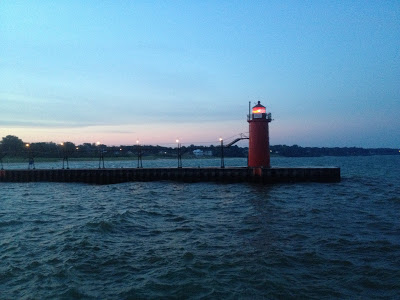
Local fisherman—the unquestioned experts on Lake Michigan—describe that day’s waves as steep four-footers, with winds of 12-18 knots. While the day didn’t start out that way, I can vouch for the fact that it definitely ended that way. In fact, by 9:00 p.m., it was even worse because rogue waves seemed to come out of nowhere as the darkness descended. Unaccountably steep and from all directions, they turned the lake into a “washing machine” of confused waves.I had checked the weather forecast the previous evening, so I knew that Monday would not be an ideal kayaking day. But the forecast didn’t look great for any day later in the week either. For a variety of reasons, we had to do the challenge this week, so why not try Monday? Our donor had already agreed he would still “pay up” even if we had to do half the challenge (South Haven to Saugatuck) on one day and the other half (Saugatuck back to South Haven) on another day. If we paddled for a few hours and decided it was too rough we could stop and finish it another day.So when Allie and I kayaked out between the South Haven piers in the wee hours Monday morning, it seemed like a reasonable decision.I had decided to take this challenge on behalf of my friends in Eastern Congo (DRC). I would donate the $10,000 to World Relief DRC for their work with grassroots peacemakers, refugees who’d been forced to flee for their lives because of
Congo’s ongoing war, and victims of gender-based violence. Experts have called Congo “the most dangerous place on earth to be a woman.” Every day, Congo’s beautiful, courageous women face threats I can’t even imagine.The night before we set out for Saugatuck, I received an email from a trusted friend in DRC. Fighting between UN forces and vicious rebels had escalated; people I knew were in immediate danger, as were the most vulnerable women and children in the huge refugee camp near the city of Goma.
So what if Monday was a rough day on Lake Michigan? It was a rough day in Congo too.In fact, it seemed the perfect day to paddle for Congo.During the first half of the day, Allie and I had the wind at our backs. Even so, our progress was much slower than we had anticipated. And then, just before we reached the halfway point, the wind velocity picked up dramatically. We passed the Saugatuck piers in a chaos of jumbled waves, elated that we had made it, yet overwhelmed with the prospect of facing into that building wind as we paddled home.
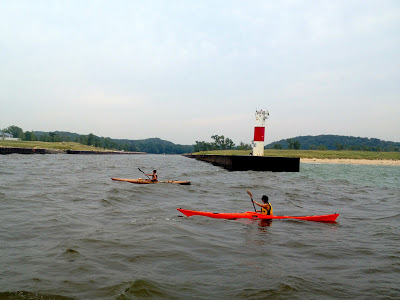
We took a short break to visit with my parents, who had come to Saugatuck to cheer us on at the halfway point. Having spent much of the last year together as my dad battled cancer, my parents and I deeply appreciate every experience we can share together. Also, my dad had contributed uniquely to the day. Allie was using my old kayak, which my dad had equipped with a custom-designed skeg in preparation for this day. A fin-shaped skeg is attached to the underside of a small boat to improve steering. Paddling along the coastline means that waves are always hitting the side of the kayak, pushing it off-course. Without a skeg, a paddler wastes energy simply trying to go straight. When Allie and I passed the half-way point at the Saugatuck pier, Dad had the pleasure of knowing that Allie wouldn’t have been able to accomplish that without his creative craftsmanship.
After our short break, we headed back out into the waves. Unfortunately, it was immediately obvious that despite the modifications my dad had made, my old kayak was inadequate for the extreme conditions we now faced. Allie was forced to drop out. From the time I planned this adventure I had expected to do it alone, so Allie’s decision to join me was an unexpected encouragement. Her paddling with me during the first half was a great boost and she was an enthusiastic cheerleader on the chase boat until the very end.With the wind continuing to build, Bill suggested that I stop, too, and do the second half on another day. It made sense, but his suggestion also made me a little mad. I felt good. How could I stop when I felt good? I decided that even if I had just one more mile in me I had to keep going.I ended up paddling for the next seven hours—and it was crazy!Endurance athletes could probably predict the highs and lows I experienced during those hours, but it was all new to me. I’d never before pushed the limits of my physical endurance, never reached a point where I was sure I could not keep moving my body—and then pushed past that! I now understood how my daughter Shauna felt several years ago after she ran the Chicago marathon. It is profoundly empowering to do something you never thought you could do.During the first half of the challenge, while Allie and I paddled together, my son Todd periodically came out on a power boat—the chase boat—to check on us. During the second half, when conditions were more severe and I was paddling alone, Todd stayed with me the whole way. “You’re doing great, Mom,” he called out to me. “Only twelve miles to go. Three more miles and you’ll be in single digits. You can do this!” Todd was a great cheerleader. Generally a person of few words, he was generous with encouragement while I paddled. “Awesome, Mom! You’re doing awesome! You just made it another mile!” Amazing how those words inspired me.I was exhilarated when I felt the wind drop a bit at that twelve-miles-to-go point, then devastated two miles later when it picked up again. I could describe in detail each point along the way when it seemed that no matter how hard I paddled I seemed to be going backwards. But each low was followed by a high when something strong and unexpected kicked into my arms and I found myself moving forward again.My husband Bill was on a separate chase boat, coming and going throughout the day. I appreciated his effort in bringing my parents to Saugatuck and then taking them back safely to the South Haven harbor. Later in the day, at a crucial moment, he again motored back to land and got me a chocolate milkshake from Dairy Queen. I have not had a milkshake in years, but for some reason that's the only thing I craved for "dinner on the water" and it definitely boosted my energy.During one stretch I think I experienced what it means to be "in the zone." There was the perfect combination of being at the right angle to the waves, motivation from seeing a familiar landmark on the beach, and the hum of the chase boat behind me. For about thirty minutes I felt like a machine. I felt like I was sprinting. I knew the convergence of forces creating this energy was fragile and temporary, but I chose to enjoy it while it lasted. And I held it in memory later, when I was so frustrated with the conditions and with myself that I had to fight back tears.Despite the occasional dramas, there were long stretches when I could settle into a paddling rhythm that allowed for reflection. I found myself asking two questions over and over again: Why am I doing this? What does this matter?There was, of course, an easy answer to the first question. I was doing this to raise money for Congo. But throughout the day it became increasingly clear it was about more than money. I felt an intensity of intention—I don’t know what else to call it—that went well beyond thoughts of what $10,000 could do in Congo. I became convinced that if the financial incentive were eliminated altogether, I would still feel that same intensity, that same feeling that, I have to do this for Congo. That surprised me. What was that about?Throughout the day, I prayerfully recited names of friends in Congo—Marcel, Cyprien, Charles, Dr. Monique, Charlene—and envisioned faces and photos and scenes from my travels there. I wondered what was happening on the streets of Goma, in Rutshuru, at the World Relief headquarters, in the various IDP and refugee camps. Was the violence waning or escalating? Were my friends safe?
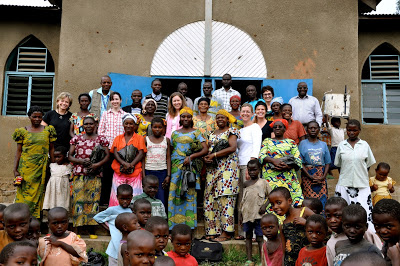
To the “why am I doing this?” question I settled on this answer: I am doing it as an act of identification and prophetic imagination. As I beat against the violence of these waves, I am beating against the violence that rips apart Congo. As I set my gaze against the wind, I am staring down the forces of evil and destruction. It is paddling as solidarity.Does it matter? Does an act of solidarity a continent away from atrocity make a difference? I don’t know. Objectively, I suppose not. I have no illusions that anything changed on the ground in Eastern Congo because I was paddling on a lake in Midwestern America. Headlines tell me right now, even while I’m writing this blog, about “heavy casualties as Congolese troops and UN forces pound M23 rebels near Goma.” Heavy casualties. That is terrible, awful, horrific news. My paddling didn’t do a thing to stop that.And yet . . . I had to do it. I had to keep paddling. At a certain point I knew I would stop only if my body literally quit working or if darkness made continuing impossible. For Congo, I had to keep going. I was shocked by how deeply I felt that. Amazed by how connected I felt to Congo while I was paddling.
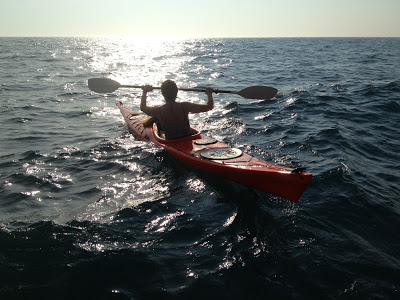
After the sun set around 8:30, daylight lingered for a while, but there was no moon. By 9:15, it was pitch black on the water. Though I couldn’t see the rogue waves coming, I could see the lighthouse in the distance and that seemed to be enough.There had been times during the day when every muscle hurt, when I was sure I couldn’t go on. But suddenly, as darkness descended, nothing hurt—I mean,
nothing hurt! After nearly fifteen hours of paddling—seven hours directly into the wind—that felt like some kind of miracle and inspired me to keep paddling. I knew these last miles would be the slowest of the day. And yes, it was a little scary in the dark. Still, I’d gone too far to stop.But at 9:45, my unflappable, last-person-to-give-up, always-pushing-to-extremes husband said it was over. “It’s too dangerous, Lynne. I can’t let you go on.” I knew he was right. I was putting not only myself in danger, but also Bill and Todd, who’d been trailing me for hours on the chase boat. Amazingly, my little kayak was taking the waves better than their big boat. I was tossed a bit by the waves, but they were hurled upward and then came crashing down. They wanted to stay close to me to keep me in their light, but feared they’d run over me when a wave threw them off course. We’d spent too many years on Lake Michigan to take this situation lightly. I knew Bill was right. I had to stop.So, after 32 nautical miles, with only 4 to go, it was over.Since last Monday, I’ve been thinking more about acts of solidarity. Maybe such acts matter only to the people doing them. I wish that weren’t true, but if it is, I think it’s still worth doing them. Even if I didn’t change Congo by paddling harder and longer than I thought I could, I certainly did change my passion for Congo. Maybe that’s all I had the power to change and maybe that’s what I was called to change. I will say this: Monday’s experience fueled an energy in me that is still building. An energy to advocate more effectively, speak more loudly, fight with greater intensity—not just for Congo, but for whatever needs fixing in this broken world. I discovered there's more in me than I thought and I need to use it for greater good in the future.I’ll probably go on pondering this for a long time.Today, I’m waiting for the fog to lift because I still have 4 nautical miles of paddling to do before I’ll have the $10,000 check for Congo in hand. Despite what I learned about the non-financial value of acts of solidarity, I am still eager to pass the actual check along to my friends at World Relief.
And I would still encourage any of you to donate $10 to World Relief Congo by texting CONGO to 505-55.In the bigger world of #MaybeICan2013, my friend Belinda Bauman is still planning to run a
half-marathon for Congo. Go Belinda! My friend Laura Crosby is still pounding the asphalt in Minneapolis to raise money for
clean water in Africa. Laura, I can’t wait to compare notes on the lessons of physical endurance! Steve Wiens is still training for his
RIM to RIM race through the Grand Canyon to raise $50,000 for victims of sex trafficking. Steve, I’m so inspired by you! I know others who are still working out details of their own #MaybeICan2013 challenge. Cheers to the lunatics!My pastor friend Chris Seay and his Ecclesia congregation donated $1,000 to the kayak challenge. That will be used for Syrian refugees I’ll be visiting in Jordan later in the fall. Thanks Chris! (I’ll be contacting you soon about that check….)The amazing Allie earned $5,000 for the charity of her choice. Thanks, Allie, for joining me in this adventure, for helping me pace well during the first half so I’d have energy for the second, and for cheering me on the whole way. I love that I made a new friend this summer!
